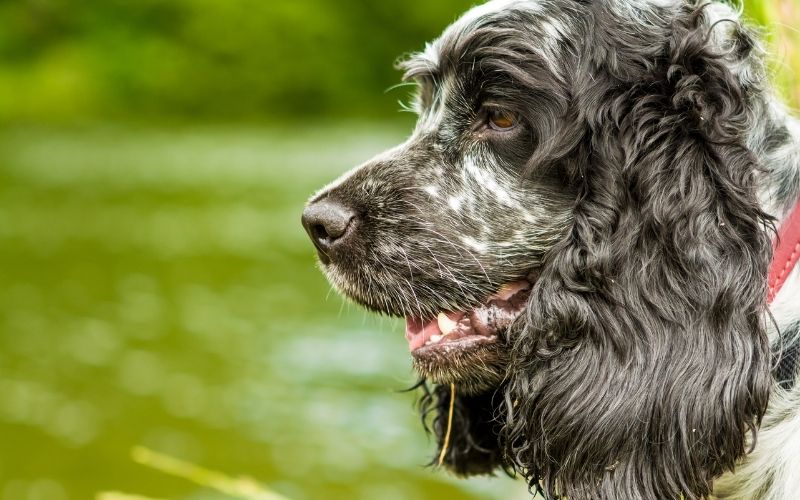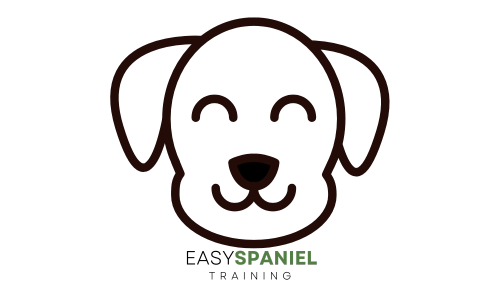The Cocker spaniel coat comes in a wide variety of colours including fawn, tan, black and more.
You may have come across the term ‘blue roan’ and wonder just what type of colour this is and how it applies to Cocker spaniels.
Many animals have what is termed roan coats, they are generally a fine mix of different colours, often seen as fine flecks in darker areas. Cocker spaniels can be found with a variety of colour combinations, one of which is blue roan which is, as expected, a combination of light and dark blue like colours in the coat.
Blue Roan Cocker Spaniel
The Cocker Spaniel, in this combination, will have a blue to black and tan and black and tan and so on.
The colours can be mixed throughout the coat or mostly found in certain areas such as the ears, back and tail areas.
They often have lighter undertones which are normally light grey or blue in appearance.
What does roan mean in Cocker spaniels?
Roan is a coat colour pattern that can occur in many different dog breeds.

A roan coat is made up of two colours – the base colour, which is usually white, and another colour mixed in evenly throughout.
So, for example, a blue roan cocker spaniel would have a blue coloured coat with white hairs mixed in.
Roan is different from merle, which is another coat colour pattern.
Merle coats have patches of colour on a background of another colour, whereas roans have an even mix of two colours throughout the entire coat.
A Comprehensive Guide to Blue Roan Cocker Spaniels
Do Blue Roan Cocker Spaniels Get Darker?
Do Blue Roan Cocker Spaniels Shed?
Why are some Cocker Spaniels called Blue Roan?
Blue Roan Cocker Spaniels and Exercise – How much is Enough?
Common Misconceptions about Blue Roan Cocker Spaniels
Blue Roan Cocker Spaniels and Children
Blue Roan Cocker Spaniel names – Inspirational Names for Spaniels
A Day in the Life of a Blue Roan Cocker Spaniel – What to Expect
How do you know if your puppy is blue roan?
When your Cocker Spaniel puppy is born, the blue roan gene doesn’t actually appear for up to 12 months.
There is no guaranteed way of determining whether or not a puppy will be roan, as he develops and his coat grows his colouration can and probably will alter.
By 12 months of age, your Cocker Spaniel should have fully developed his adult coat and you’ll be able to tell if he’s blue roan or not.
Blue roan puppies tend to be darker in colour than adults, but you may still notice flecks of lighter blue and grey throughout the coat.
Although ‘blue roan’ is a term that would apply whatever the colour combination on the coat there are some other terms used to describe colour combinations in Cocker spaniels.

These include:
Single coloured dogs who have either a solid black or solid tan coat without any other colours present would be called ‘Self Coloured’.
‘Smut’ is a term used when a single colour is found in the top third of your Cocker Spaniel’s head. You’ll often find smuts on tan coloured spaniels.
Multi Coloured – These are usually dogs who have other different colours throughout their coat such as black and white. Some Cocker Spaniels also have black and white and tan which is known as a tricolour.
Roans are when flecks of different colours appear in the coat that look like roan horses such as blue roan, red roan or liver roan.
‘Smoke’ is a term used when the nose, paw and eye areas of a Cocker Spaniel’s coat is darker than the surrounding areas, usually black or liver.
Cream – Cream is a term used when you can see lighter colours throughout your dog’s coat such as blue roan. It would be similar to the colour of cream ice cream.
‘Ticking’ is another term that can be used for this type of colour on Cocker Spaniels. Ticking is when small specks of different coloured hairs are found throughout the coat.
Sometimes you’ll find little flecks of brown or black in your cream coated dog, these are known as ‘saddling’ or ‘marbling’.
Grooming Blue Roan Cocker Spaniels
Training Tips for Blue Roan Cocker Spaniels
5 Reasons why Blue Roan Cocker Spaniels make Great Family Pets
How to Determine if Your Cocker Spaniel Puppy is Roan
What makes a Blue Roan Cocker Spaniel Unique?
Choosing the Right Diet for a Blue Roan Cocker Spaniel
How to find a reputable breeder of Blue Roan Cocker Spaniels
Checking your pup’s colouration
If you’re in doubt about your Cocker Spaniel’s colour check his registration or pedigree papers.

These should contain information on the colour of your dog and any other details such as markings, eye colour and so on.
The Kennel Club provides a guide to understanding Cocker Spaniel colours which is really useful if you want to know more about this subject.
The Kennel Club also provides a quick reference to all colours by clicking here.
[amazon box=”1906305293″ template=”horizontal”]
How long do blue roan Cocker spaniels live for?
The average life expectancy for Cocker spaniels is 11 years although some can live up to 13 years.
There are various health conditions that can affect your Spaniel including eye problems, ear infections, arthritis and so on.
These conditions could have an impact on how long your dog lives or if he lives a full lifespan.
Are blue roan Cocker spaniels unhealthy?
There is no apparent reason why blue roan Cocker Spaniels should be any less healthy than other types of cocker spaniel.
Some people with certain dog breeds like to make claims that they are not as healthy as others, but this is usually because they are a popular breed and there is a high demand for them.
Blue roan cocker spaniels can still have some of the same health issues as other dogs, such as eye problems or ear infections.

Do blue roan Cocker spaniels bark a lot?
There’s no reason why blue roan cocker spaniels should bark more than any other type of dog.
However, it depends on the individual and how much they like barking.
Some Cocker Spaniels tend to make noise a lot more than others.
It can be hard to train them not to bark too as this tendency may be genetic and is hard to avoid.
Do blue roan cocker spaniels shed a lot?
Like with all dogs, there is no guarantee that your Cocker Spaniel will not lose hair or create hairballs.
There are many factors that affect how much a dog sheds including diet and exercise.
However, you should expect more shedding if your dog has a double coat.
A double coat is typical of spaniels, which helps them cope with cold weather.
Their top coat acts like wool and keeps the dog warm while their undercoat is made up of fine hairs that help to keep warmth in and wind out.
Cocker Spaniel coats will usually grow to a certain length and then halt.
You can prevent them from going too long by brushing your dog every couple of days.
Are blue roan Cocker spaniels rare?
Although blue roan Cockers are not rare, you are less likely to see one than the other colours of the breed.

What is the temperament of a blue roan Cocker spaniel?
Blue roan Cockers are mild mannered and biddable dogs that enjoy exercise and spending time with their families.
Research suggests that Cockers with patches of colour are more mild mannered than those without.
Are blue roan Cocker spaniels easy to train?
Yes, blue roan cocker spaniels are relatively easy to train.
Like all dogs, they will need patience and consistency from their owners during training.
Blue roans are intelligent dogs, and they’re quick learners.
So as long as you’re willing to put in the time and effort, you should be able to train your blue roan relatively easily.
Final Words
All in all, blue roan cocker spaniels are completely normal dogs with the same potential health issues that any other breed of dog has.
There’s no reason to believe that they will be unhealthy or have a shorter lifespan than any other type of Cocker Spaniel.
They can make great family pets and love nothing more than to be with their owners.
If you’re thinking about getting a Cocker Spaniel, whether it’s a blue roan or any other colour then you can read my article here on Choosing a spaniel puppy for more advice and information.




